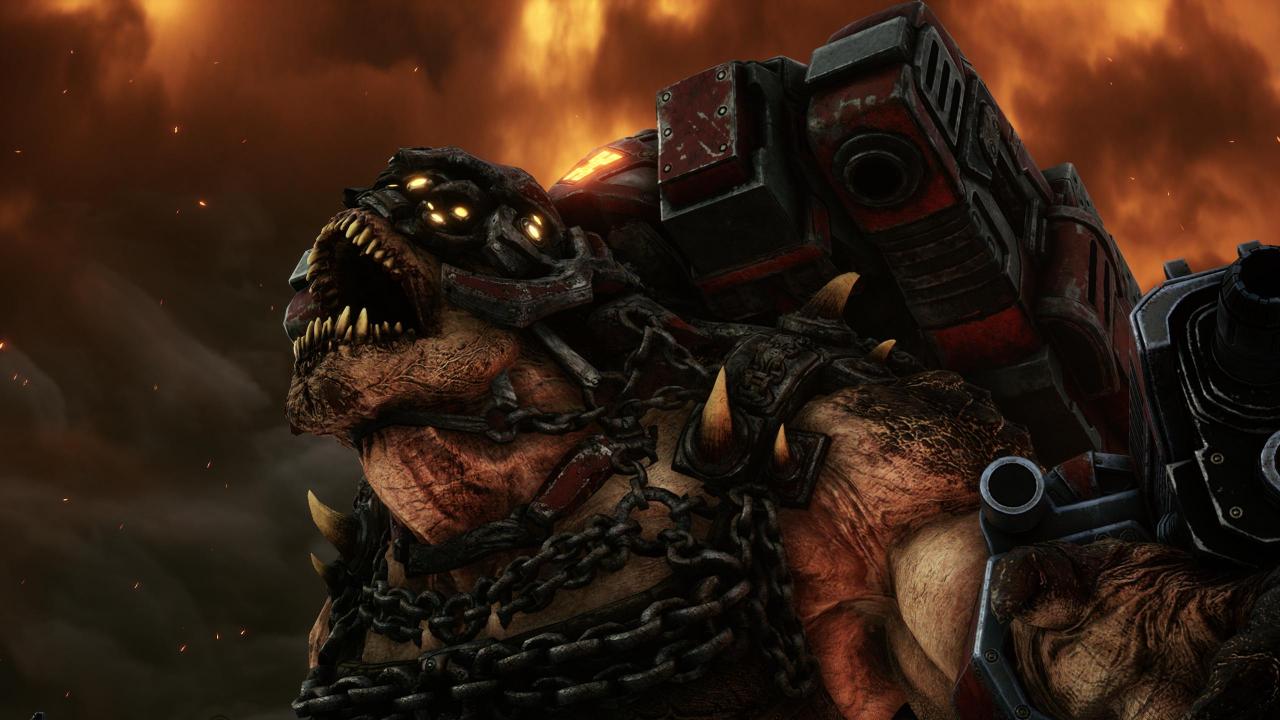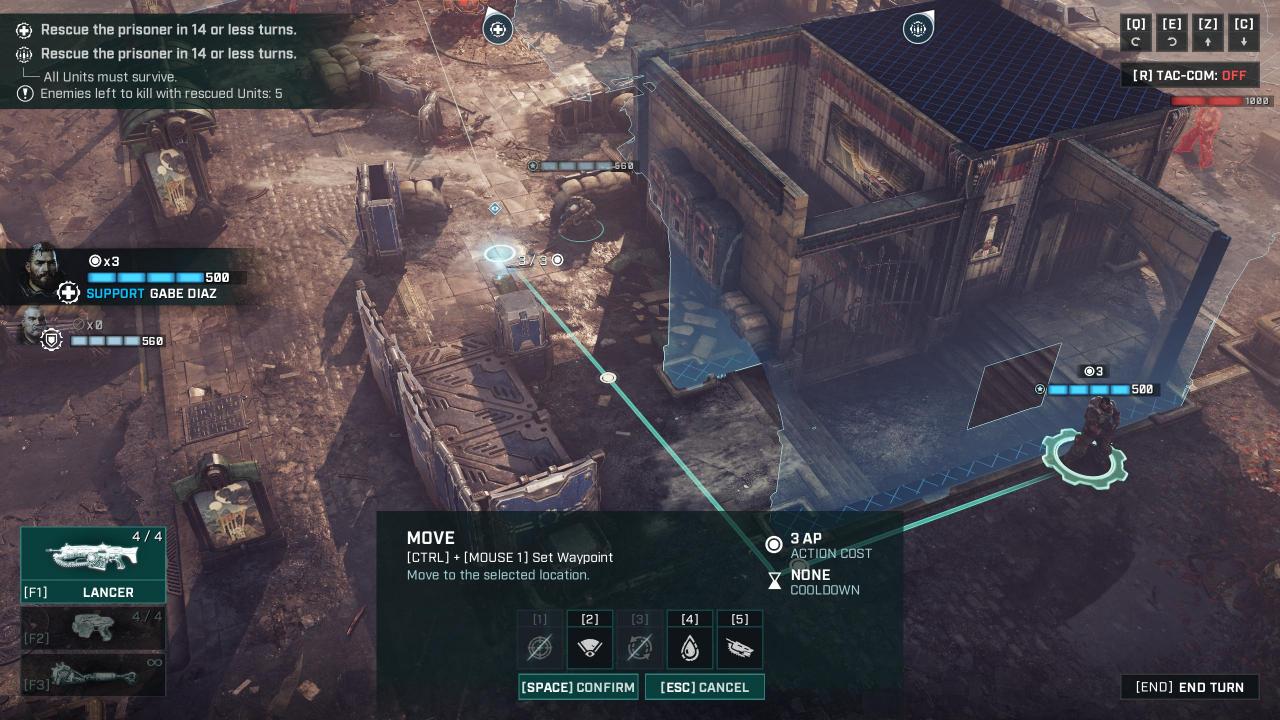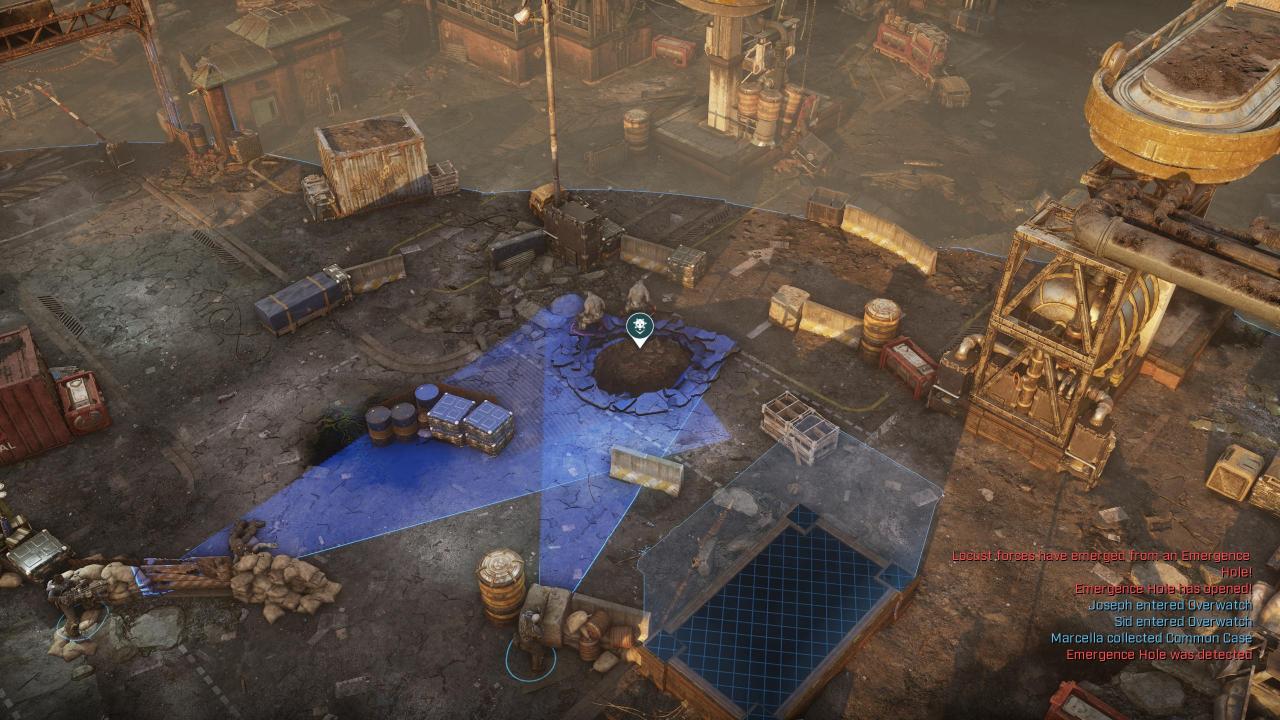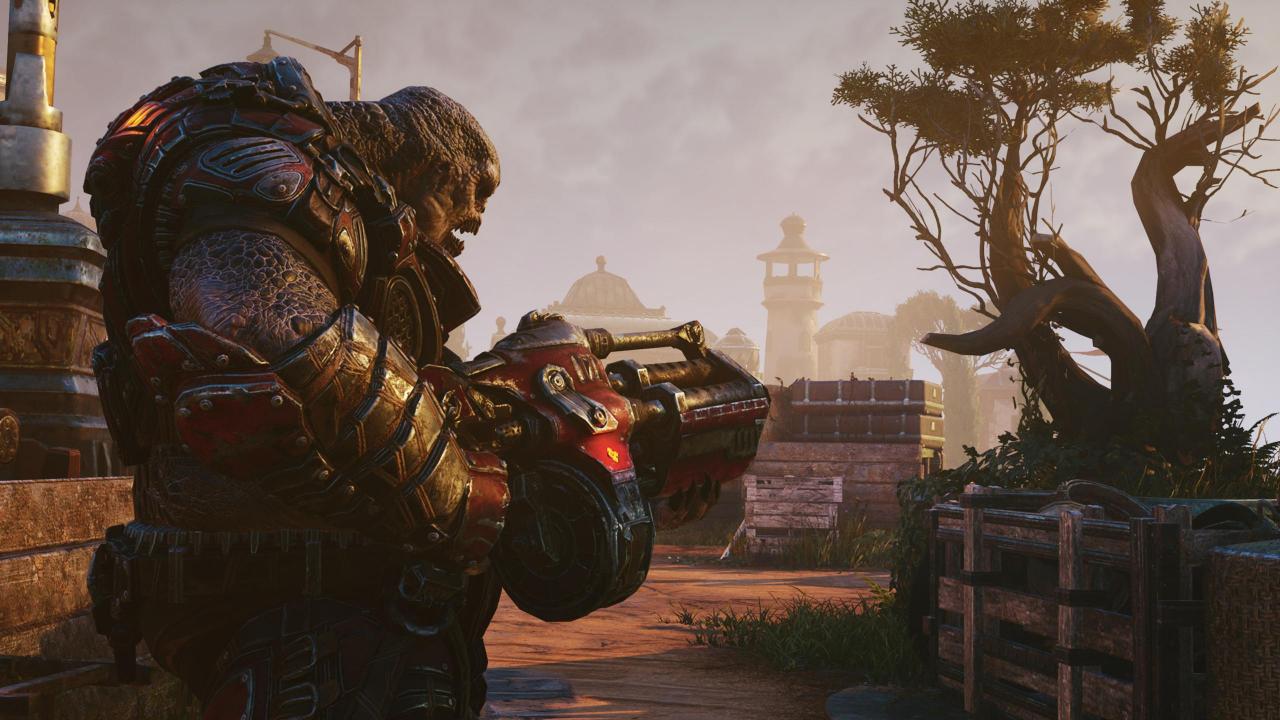The Gears of War series is one of my favorite franchises outside of wargaming. Why? It was released in early Xbox 360 days, when I was a teenager. Are the protagonists big, burly and very manly? Hell yes! Industrialized, grimy look? Give me that industrialized look. What about a testosterone-filled, romp where you slash large and dangerous creatures into half with a chainsaw attached to an assault rifle barrel? Please, more!
Gears of War, for those who didn’t know, was originally a cover-based third-person shooter. It came as a complete surprise (and it wasn’t just me, given the initial reactions to the game) when Microsoft revealed that they were going to slow things down and swap the fast-paced, third-person shootouts with a 3D, cerebral tactical experience. It was understandable for traditional Gears of War fans to be suspicious. It was well known that the game’s gung-ho approach and fast-paced gameplay appealed to an audience very different from those who enjoy tactical strategy. But (! Look behind the curtain of overt, intrepid maleness and you’ll see why Microsoft chose the Gears cover-based game as the perfect backdrop for their latest adventure. Gears is a cover-based shooter that features hunky men shooting each other in the face until they both die.

What other game does this? Well, XCOM! You can add a few grenades throws and some skills to make a good game. It just so happens that yes. Gears Tactics offers a solid gaming experience. It’s not perfect, and I will point out all of its flaws, but it is a fun, commendable game if you are tired of waiting on XCOM 3 to come out. Why couldn’t Gears be a hit like Mario and Rabbids, which was also a surprising success? Gears topped the Steam Sales Charts on the first day of its release, and it has arguably had a decent performance even though sales figures are not known.
Presentation: for Gears of Tactics looks absolutely stunning. Aside from a few minor missteps, the presentation is where this game shines without major problems. Environments are stunning, and the “industrialized but futuristic 19th century” style is beautifully realized. The dark and ruined alleyways of the game are just as stunning as colorful maps or exotic locations. This game has a wealth of environmental detail. The game is filled with environmental details. Everything appears worn and dirty. Only small patches of greenery sprout from the ruins of buildings or stretches of road. Character models need to be reprimanded, but the absence of a zoom-in feature really detracts from the work that artists put in to bring it together. Gears of War is a gory mess and Tactics does not shy away from that.
The death melees of locust units are horrifying and painful. They include bayonets and chainsaws as well as shotguns, chokeholds and grenade slaps. Camera issues persist two years after release. It’s annoying that the camera does not zoom in completely. When your Gears fire at an enemy, the cinematic mode isn’t active, the focus is on the Gears instead of what you’re shooting. This stupid system removes some of the enjoyment of watching another locust fall to the ground, but also prevents an instant confirmation of a kill. This is a very bad idea and it’s probably fixable.

New Mechanics Despite a few very serious shortcomings that I will mention, Gears Tactics succeeds in its goal and it is to be commended for not being afraid to stray away from the 2011 XCOM Formula that had dominated most games of this type in the past decade. There are two major changes that you will notice right away: the lack of grid-based movement and three instead of just two action points. The latter is a game changer, particularly when combined with other systems. It’s not necessary to change the grid movement system, because most of your units will be huddled up against walls as cover. This change allows for a finer level of control and, on rare occasions, can allow movement optimization. It could save you a few points, particularly when combined with the option to redirect the path. This is not the time to be applauding the unnecessary amount of complexity. But when you have a system that works as it should, and that’s clean and simple, then that just adds an extra layer to “things to track” and makes people feel smarter.
It is the new three-point system of action that has made a real difference. For a very long time movement points have been used to determine everything that is turn-based. This was always a nuisance to me but a necessary one. Let’s pretend that 100 movement points could be needed for several different actions. Moving one square would cost the unit five points. Crouching will deduct 3. Shoot and another 12 will disappear from the pool. Another 3 will disappear if you get up. You can move again two squares, but now one of them is swampland. It costs 5 plus 7 dollars. While this system allows for greater control, it is a good way to tire out less attentive players. This is made worse by the fact most units have a different number of movement points based on their level and statistics. It can feel like you are managing an excel spreadsheet rather than leading a team of elite soldiers. The two-point system of movement, which we’ll call XCOM 2011, allows all soldiers to be present and take a limited amount of actions. You can either shoot or move, or you can move while activating a skill. The system takes care of boring things like “crouching”, “sprinting”, and its strict limits force players to optimize their actions. Once those two options are gone, the only thing left is hoping that your enemy does not have a clear shot. The pressure of this system is increased by the fact games like XCOM work better with Ironman Mode on. This means that players must be certain about the action they want to take. This system is enhanced when combined with special abilities and other modifiers that create cool, but fair, combos. XCOM 2 excels at this.
Gears Tactics’ developers realized this, and decided to go all out by adding a third movement/action. This creates a forgiving system, but in the context of an invasion by aliens like XCOM this wouldn’t be right. The Gears series was about power fantasy and explosive action. It makes sense that the protagonists have more options. They can now move into a better location, fire and then relocate. Or move further to shoot. Shoot three times or more! Shoot twice, then reload. Move, shoot, heal etc. Gears of War developers have opened up a Pandora’s Box of possibilities for the players with this tiny change to the 3D tactical, turn-based game design.
When almost all Gears are shot down they will enter a vulnerable state and be susceptible to melee killings. This allows them to gain another movement point for all Gears except the one who is doing the melee. Gears has a lot of enemies. So, if you have three down, kill them all and your unit gets six actions instead of 3. This can lead to some wild results that snowball very quickly. This is similar to the way you set up combinations in Tetris and Bubble Trouble. It also encourages players by offering options such as killing many enemies on the same turn. The action points don’t stop on the map. This system will allow you to refresh certain skills, award more points to teammates and give some equipment a chance of giving a unit another point. The system increases the unpredictability of the action, and makes players feel like tactical masters. This is even though it is designed for this type of gameplay and experimentation. This system also adds a certain ebb and flow to the game, which is perfect for a Gears franchise.

It is my pleasure to thank the person who implemented the field of fire in the overwatch mechanism. It’s not a new concept, but its presence forces commanders in digital games to think more about their choices (because an unit that can flank the Gears will do so). This kind of overwatch is also less reliant on “move-and-overwatch”, which other games have become famous for. The enemy is also included in this overwatch restriction, which makes it easier to determine the killing zone and what targets should be prioritized if friendly units are being pinned down.
Bosses and Enemies:The variety and quality can make or ruin a game such as this.
Gears Tactics is a good game within the constraints of the existing franchise. Here, the typical enemy cast appears: Hammerburst Drones fire at COGs using their same-named rifles. They are a waste of cannon fodder unless they’re placed in a very tight situation. The Wretches do not go into the “downed” state that I described, so you are able to kill them in large numbers using grenades. At first I thought that this was the only unit within the game, and there were just two variations. But it wouldn’t be long before the more deadly Locust are introduced. Early on, Grenadiers will lead the charge against your plan. The grenadiers have a large pool of health and it takes several units to take them out in one turn. They can also do massive damage if you get too close. You will also be punished if you use close combat tactics. They do more damage if they are injured, and will attack you a lot – even causing a massive explosion. The tickers are disgusting and they will self-destruct if you get too close. Funny enough, kicking them in the middle of an enemy group and shooting at it can cause a huge explosion that damages everyone. The snipers are not impressive and only one time have I seen them do anything other than get killed in the first turn. This was a mission on the map of the bridge crossing. They mostly just wait and hunker-down to get killed.
The Guard and Boomer are my favorite enemies. It might seem like I enjoy being punished but it is the ability to pick up weapons from their corpses that really makes them fun. It’s also possible that not dying from a fiery blast would be enough motivation. You can find a few more enemies in the late game, which are basically stronger versions of this unit. But you get it. The gist of it is, these enemies are fun and challenging to deal with. Each will require different strategies and you may even be rewarded for some. There’s not much to criticize, except for the useless snipers. The developers were forced to stay within pre-established enemies and storylines. It’s time to discuss bosses, but what do you think? These bosses are boring and uninspired. They’re a pain to fight. This is my opinion, which may not be popular: the same thing happens with bosses in the Gears of War mainstream games. These are just large health bars which overstay their welcome by the 5th turn. I’d have rather invested the money and time spent creating these battles in more regular enemies.

Trouble in Paradise This review has been largely positive. The story is about to take a turn. After the first act, I was bored with the story. It’s just a bunch of people trying to do the best they can. It’s also very linear with little room for randomization. Some side missions are only there to extend the length of the game, and can become repetitive if you play the same mission twice. This game is not replayable. There were later additions that filled this gap but this review is only focusing on the basic experience. To me personally, I think this is what makes a game so bad. XCOM is a great game because you can experiment and create non-linear storylines with your characters. The forced protagonists in the game are also a burden that becomes too much to bear. Certain units have to be forced into certain missions, while others get blocked for narrative reasons. The tactical 3D combat system is a strange one. It offers a lot of options, but the story and management layers sabotage the entire thing. The game looks as if it was designed by two different teams, then merged into one. This resulted in a Frankenstein mix with too many and too few options. The lesser meta-layers are more important than the tactical ones, and this weakens the base of one of the best turn-based strategy games in the past decade. The story, and management layer were treated as an afterthought. This will be remembered as the perfect example of how bad design can bring a good combat system down to the level it deserves. It’s a shame, and it could have easily been avoided by switching to random mode instead of trying glue everything together using a storyline that wasn’t necessary.
It feels as if the on-rails game was forced into the system of randomly dropping loot after each mission. The existence of legendary loot in a box on the battlefield is also out of the ordinary. The game should take a page from XCOM’s book and introduce a base system. (I suspect that this feature was scrapped because one of the very first tasks you perform is to secure a huge vehicle which will be used as a foundation for operations. But it just sits there). It’s also important to mention the lack of weapons. However, this did not bother me nearly as much as some other issues. If it were up to me everyone would run around with shotguns and chainsaws.
There is also a game-breaking glitch that you can’t ignore: enemy units sometimes get stuck in the middle of a mission and will spin around in circles.